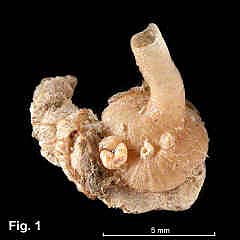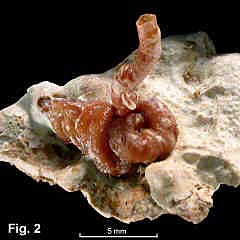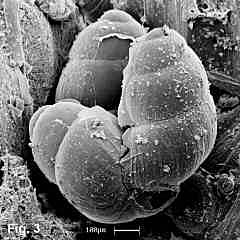|
|
|
|
|
Petaloconchus caperatus (Tate & May, 1900) Description: Shell irregularly coiled in early whorls, these often laterally displaced and attached to substrate; last section of shell an upright, straight, relatively smooth tube. Remains of early upright tubes sometimes visible. Surface irregular. Operculum corneous, transparent, with spiral lamella. Colour white, fawn to brown. Size: Attached mass typically 10 mm maximum dimension. Upright tube typically 5 mm high, tube diameter 1 mm. Distribution: Full extent of range unknown, but at least Sydney, NSW, around southern Australia to Rottnest Island, south-western WA. Habitat: Under stones on rocky shores at mid tide level and below. Comparison: Much smaller than Serpulorbis sipho. Remarks: This species produces a tube section standing upright from the attached shell mass. The remains of earlier upright tubes can be seen in some specimens, apparently removed when the mollusc started a new phase of growth. The protoconch is of 2.5 smooth whorls, from which the teleoconch develops at right angles. In Fig. 1, and enlarged in Fig. 3, three larval shells can be seen loosely attached near the base of an adult shell. The radula, operculum and protoconch are described by Hedley (1902b, 1908). Hughes (1993) figures the radula, shell, operculum and external morphology of the animal. The definition of the genus Petaloconchus includes spiral lamellae inside the shell, as noted by Wilson (1993). They are not present in the specimens on hand. Hughes (1993) considered this character variable for the genus. Fig. 1: Balmoral, Middle Harbour, NSW (C.011040) Fig. 2: Bare Island, Botany bay, NSW, in 12 m (C.083303) Fig. 3: Close up of same specimen as Fig. 1 (SEM photo Sue Lindsay) |


